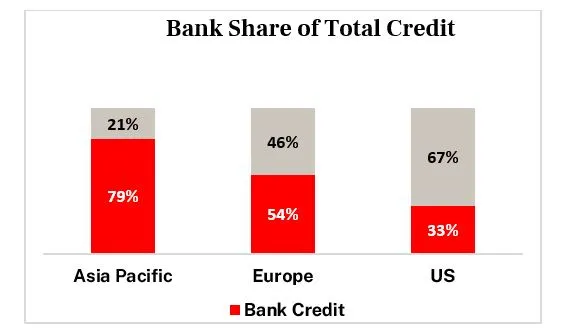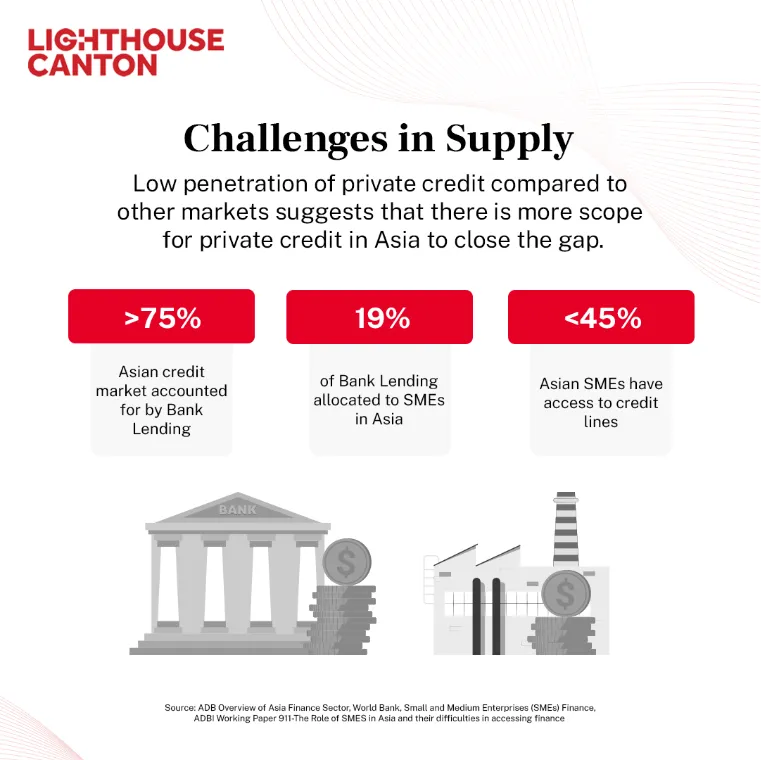Unlocking Asia's Private Credit Potential: Opportunities, Growth, and Challenges
Article by Sanket Sinha, Managing Director & Global Head of Asset Management, Lighthouse Canton and Ankit Agarwal, Director & Portfolio Manager, Venture Debt, Lighthouse Canton
Asia's ascent to global prominence has been remarkable. Housing three (China, Japan, and India) out of the five largest economies in the world, Asia already accounts for the bulk of global growth and is poised to grow in magnitude with an anticipated contribution of about 2/3rd to the global growth in 2024, the same as in 2023. In 2023, Asia saw economic growth of 4.7% against the global economic growth of 3.1% and is forecasted to grow at 4.5% in 2024 against 3.1% for the world economy.[1]

Asia is expected to lead the world in global consumption growth as the middle class expands, accounting for 56% of the world’s middle-class households.[2]The region’s households accounted for nearly 42% of the world’s wealth, or US$ 218trillion, in 2020.1 According to the Brookings Institution, the region makes up 50% of the world’s 4-billion-strong consumer class[3] and India and China alone are projected to add 64 million more people to that consumer class in 2024.[4]Meeting the needs of these new consumers will require new businesses, the expansion of existing businesses, and ultimately, more capital. We believe that central to this growth will be the region’s rapidly expanding privatecredit sector. Once a relatively unexplored segment, the region's private credit market now presents a wealth of opportunities for investors, lenders, and businesses alike.
Private Credit in Asia
To support this swift growth momentum, Asian businesses require diversified capital to meet a range of funding needs. Some businesses are growing into global players, while some family-owned companies are trying to figure out how to transition to a more institutional model. Entrepreneur-led companies want to finance growth without diluting their ownership interests prematurely. Such businesses are increasingly looking at hybrid, customized financing solutions; and this evolving requirement is not being met entirely by traditional lenders in Asia.
Traditional bank loans have long been the primary source of funding for businesses in Asia-Pacific accounting for 79% of all credit, about 2.5 times the US share of 33%.[5]However, the economic growth in recent years has resulted in the emergence of new borrowers with varied financing needs; traditional lenders have not been able to keep pace with this demand.

In many developing Asian economies, SMEs are the backbone of the economy, accounting for a significant portion of the region’s GDP but often struggling to secure financing from traditional lenders like banks, who may view them as too small or too unstructured. Asian SMEs, which represent 96% of all business enterprises in the region, currently face an estimated financing gap of US$5.2 trillion every year.[6]
Fueled by shifts away from middle-market lending by banks and public lenders and the increasing financing needs of SMEs, private credit strategies have quickly looked to fill this gap, significantly fueling Asia’s growth. Private credit solutions have helped businesses fulfil a diverse range of requirements from growth capital to refinancing and working capital through a range of financing options including secured medium-term and long-term financing, acquisition financing, revolving credit lines, short-term bridge financing, supply chain financing, venture debt, mezzanine financing, and special situations.
While banks have scaled back lending to mid-market and SMEs, the Asian private credit market has benefited by moving fast and providing flexible solutions to adapt to the business of the SME while covering downside risks for investors. As a result, private credit has grown by almost 30x in the last two decades, from US$3.2 billion in2000, to over US$90 billion in June 2022.[7]
With Asia’s share in global trade rapidly increasing, cross-border financing requirements have increased. This has led to a rise in demand for supply chain financing solutions such as trade finance and flexible short-term capital to fulfil immediate capital requirements or any working capital shortfalls as businesses continue to expand their global footprint.
The startup ecosystem in Asia has seen rapid growth. China and India are respectively the 2nd and 3rd largest startup markets in the world, accounting for over 450+ unicorns between the two regions. With equity markets facing challenges around elevated valuations across 2022-2023,early-stage companies are looking at non-dilutive financing alternatives to venture equity capital to continue to fuel their growth and expansion ambitions. This is where venture debt, or financing to companies backed by venture capital, has found an entry in Asia. A recent concept in Asia, venture debt’s share stands at about 2-3% of the total venture funding in Asia compared to 15-20% in a more mature venture ecosystem such as the US, which indicates a significant growth potential for this type of financing in Asia.[8]

Not withstanding this growth, private credit remains relatively nascent in this region as APAC-based private credit AUM is at merely 6% of the global total contrasting strongly with Asia’s share of global AUM which stands at 30%.[10]There are extremely compelling demand drivers for private credit as traditional sources of debt capital are constrained.
Bridging the Financing Gap: Supply Chain Financing & Venture Debt
Southeast Asia and India have shown promising economic indicators such as strong GDP growth forecasts, low inflation, and strong digital economies. Led by the boom of technology and e-commerce, SMEs and mid-market corporates in sectors such as infrastructure, shipping, and construction, as well as startups are poised to ride this forecasted economic growth. Many of these businesses rely on private credit strategies such as Supply Chain Financing and Venture debt to address their financing needs.
For example, supply chain financing can provide SMEs and mid-market corporates short-term credit, enabling them to optimize their working capital and providing liquidity to both buyers and sellers. While suppliers enjoy faster access to money owed to them, buyers have more time to pay off their accounts. For investors, such short-term debt transactions provide direct credit investment opportunities that prioritize capital preservation and offer relatively attractive liquidity terms.
For startups, Venture Debt acts as an affordable financing option, as it helps avoid diluting shareholder equity for companies in their early to mid-growth phase. While improving liquidity, venture debt helps companies navigate market volatility and minimize short-term capital gaps. For investors, it is an appealing asset class that provides consistent returns and is an effective way of gaining access to the startup ecosystem without waiting a long time for their capital to be returned.
Venture debt is in a nascent stage in the Indian and Southeast Asian markets compared to the US but is expected to grow as a viable financing option for the region’s high-growth startups. The startup ecosystem in the region has seen rapid growth, as India has emerged as the third largest start-up ecosystem in the world after the US and China, and venture debt in the region is expected to reach US$ 6-7 billion in annual deployment in the next three to five years from the current US$ 1-1.5 billion.[11]
These alternative financing mechanisms have enabled businesses to access the capital they need to grow and expand, while also providing investors with new opportunities to invest in high-growth companies.
Potential of Asian Private Credit
Private credit is still at a nascent stage and comparatively is significantly under-allocated as compared to other markets. With non-bank lending in Asia lagging that of more mature markets such as the US and Europe, and banks scaling back on lending to mid-market and SME businesses, private credit presents an exciting opportunity in the region to bridge the funding gap for businesses and investors alike.

The significant funding gap in Asia has been amplified by limited access to the high-yield market in the last 12 months due to financial and geopolitical headwinds. The encouraging development is that over US$ 650 billion from private equity is set aside and ready for investment in Asia.[12]This is likely to catalyse investment activity across M&A transactions, and organic growth, which in turn will necessitate further financing.
Structural advantages such as the unparalleled expansion of the middleclass and predominantly young demographics in Asia are driving a surge in overall demand for capital. This, in turn, bolsters supply chain diversification and contributes to the region's GDP growth. While the demand build up for private credit has been strong, the other factors that are contributing to the growth of private credit are regulatory support and lender-friendly security enforcement laws. Enforcement of security used to be time-consuming and cumbersome, however new codes and laws, such as the Insolvency and Bankruptcy Code in India, have empowered the lenders with certainty and timeliness of resolutions and have lent support to the growth of private credit as an asset class.
Institutions such as insurance companies, pension funds, banks, and large family offices have found interest in private credit. Private credit offers stable returns with downside protection and low volatility, thereby improving the risk-adjusted return metric of investors’ portfolios. Investors looking for regular income products prefer private credit as a strategy driven by its ability to provide stable yields. Over the last few years, High Net-worth Individuals(HNIs) and the affluent segment have started investing in these opportunities through private credit funds, with India’s private credit space seeing strong growth in the capital flow from investors. In the next 5 years, i.e., by 2028, India and Asia are expected to see the largest jump globally in the number of HNIs, at 50.1% and 38.3% respectively[13]. A significant portion of this wealth generation is expected to flow toward private credit opportunities across the region as evidenced by the strong demand in India with US$ 7.8 billion of deployment in private credit deals in 2023[14].
Challenges and Complexities to Private Credit in Asia
Private credit in Asia continues to grapple with several prominent challenges. Notably, there are substantial hurdles for international capital to enter the region. Asia's fundraising environment is geographically scattered and varied. While financial hubs like Hong Kong, Singapore, and Australia are typically the sources for opportunity identification, most borrowers and assets originate outside these areas.
Such diversity implies that making an entry into Asia's market isn't straight forward. Prospective entrants face obstacles like navigating varied markets, understanding different regulatory and tax frameworks, and adapting to multiple business cultures. Traditional banks hold a distinct edge in this lending landscape, thanks to their existing licenses and their entrenched presence, enabling them to lend across various jurisdictions.
The absence of a singular currency in Asia, akin to what the US or the EU, could act as a stumbling block for the seamless expansion of its private credit market. A common currency would undoubtedly streamline financial transactions, reduce complexities, and set a standardized economic metric. In contrast, Asia's diverse currency landscape can introduce volatility and complexities, particularly in cross-border transactions. For private credit to gain ground, there needs to be a push towards mechanisms that cater to local currency financing.
The pace at which structures and documentation terms have evolved in Asia lags that of the US, Europe, and Australia. Consequently, certain sponsors question the value of paying a higher price to an Asian private credit provider, especially when the added flexibility they offer might not measure up to what's available in more mature markets.
Conclusion:
The ascent of private credit in Asia is not just a transient trend but a fundamental shift in the financial landscape. The rapidly developing private credit sector is poised to play a pivotal role in the region's economic narrative, offering a robust alternative to traditional financing, thus addressing the diverse needs of Asia's evolving markets. For investors, this represents a frontier of untapped potential, where strategic engagement could yield substantial returns. With increasing demand and supporting security enforcement laws, private credit presents investors with a unique opportunity to generate income with downside protection, thereby offering diversification to their portfolios.
As we witness Asia's remarkable economic journey, it is clear that the private credit market will be a cornerstone of its continued prosperity.
Disclaimer: Lighthouse Canton offers financial products for professional and/or accredited investors only. This blog is intended for general awareness and does not constitute investment advice .
Please take a moment to browse through a variety of intriguing topics on the Lighthouse Canton Insights page. Dive into the following for a deeper understanding of the financial trends and innovations that are shaping our world today.
- Lighthouse Canton and Korea's NH Group to Co-Invest in Indian and South-East Asian Private Debt Market
- India's G20 Presidency Sets A New Benchmark for Global Collaboration
- Lighthouse Canton Insights Podcast: Diving into India's Private Market Landscape
- Lighthouse Canton Private Market Funds
[1] IMF
[2] “Asia on the Cusp of a New Era.” McKinsey Global Institute
[3] Asia’s tipping point in the consumer class, Brookings Institution
[4] “The Asia of Tomorrow”, World Data Lab
[5] Bank for International Settlements, as of31st March 2023. Calculated as bank credit divided by total credit to the private non-financial sector. Asia and the Pacific includes Australia, China, Hong Kong, India, Indonesia, Japan, South Korea, Malaysia, New Zealand,Singapore and Thailand.
[6] World Bank, Small and Medium Enterprises(SMEs) Finance
[7] Preqin Data
[8] Tracxn, Lighthouse Canton internal analysis
[9] LC Analysis, Inc42 – Indian Unicorn Tracker, CB Insights – State of Venture 2021, CB Insights – State of Venture2023
[10] Preqin Data
[11] Lighthouse Canton internal analysis
[12] Asia Pacific Private Equity Report 2022,Bain & Company
[13] Global Wealth Report 2024, Knight Frank
[14] Onwards and upwards: a positive outlook for private credit in India, EY
At Lighthouse Canton, we are at the forefront of this transformation, committed to unlocking the potential of private credit products for our partners and clients. Together, we stand on the cusp of a new era of growth and innovation, ready to harness the vast opportunities that Asia's financial evolution has to offer. Please contact us to learn more about our private credit products.
















%20(14).jpg)
%20(4).png)
.png)
%20(2).png)